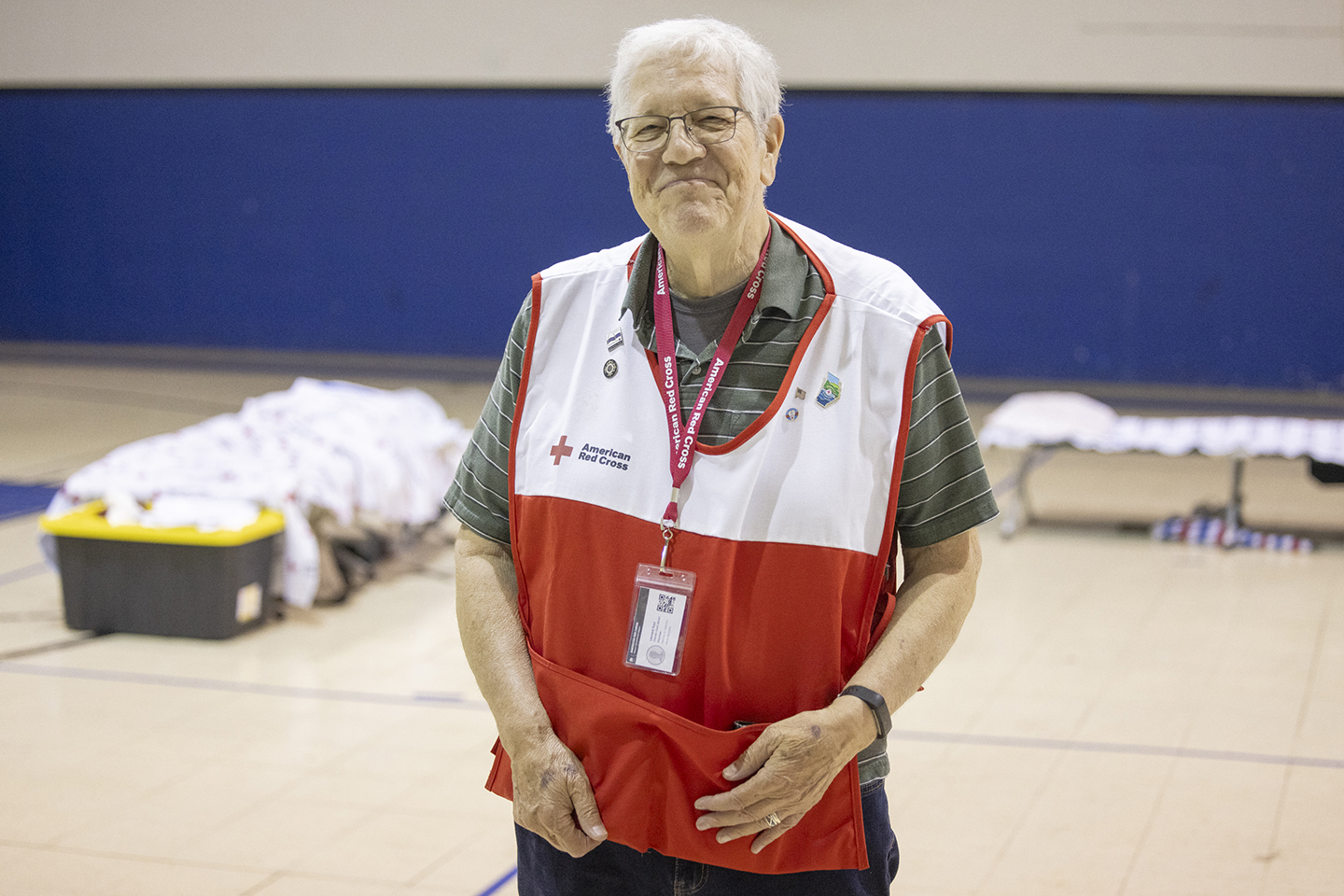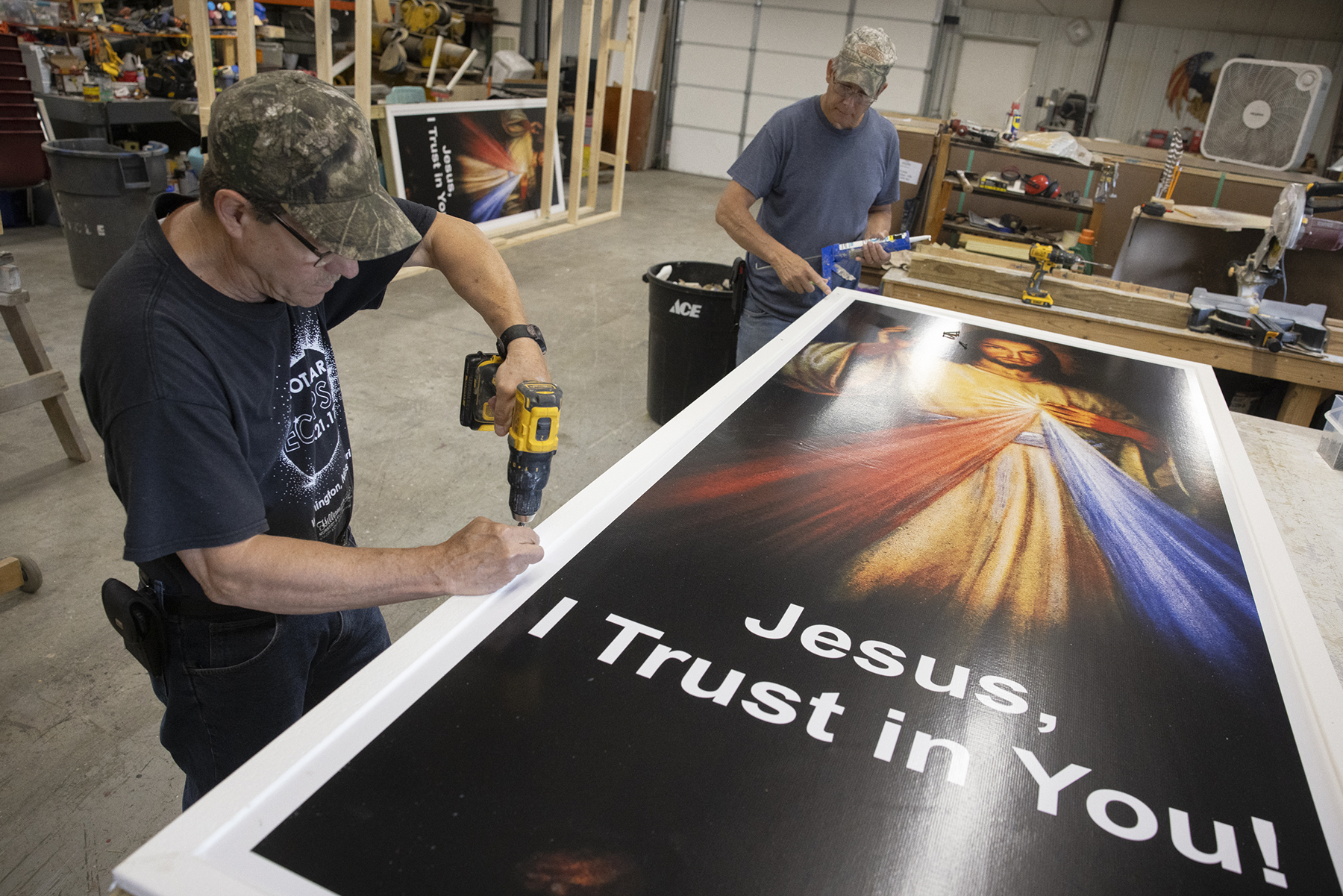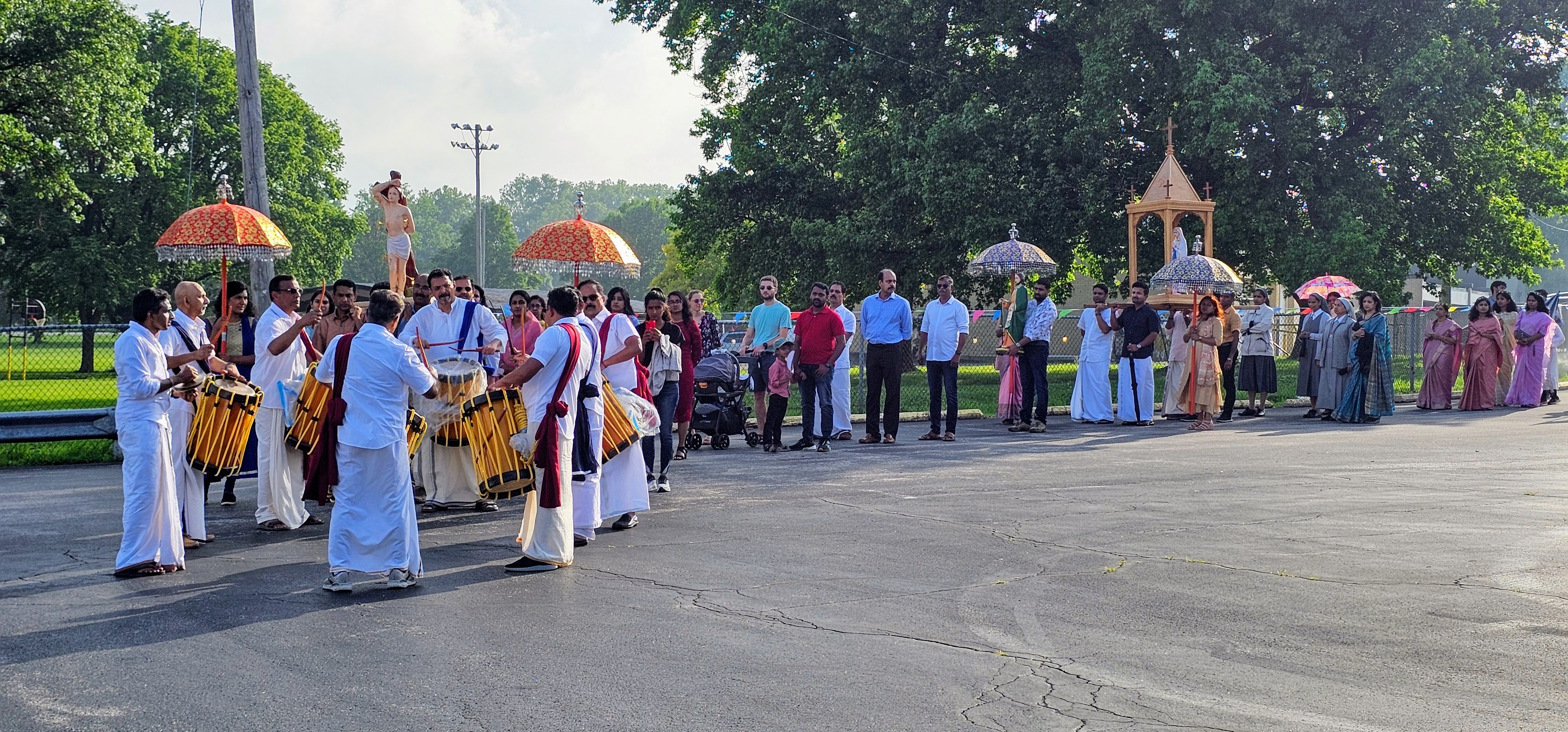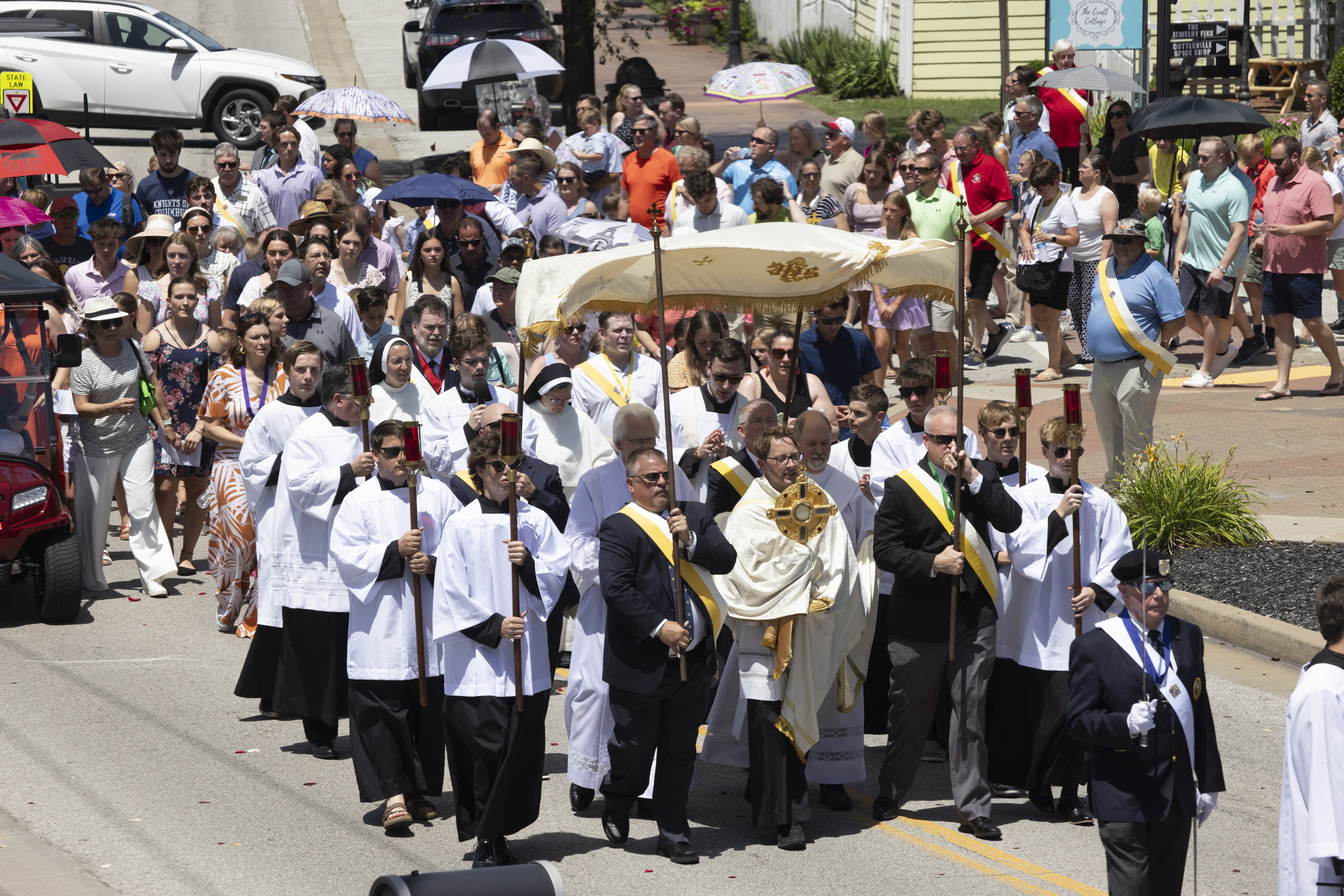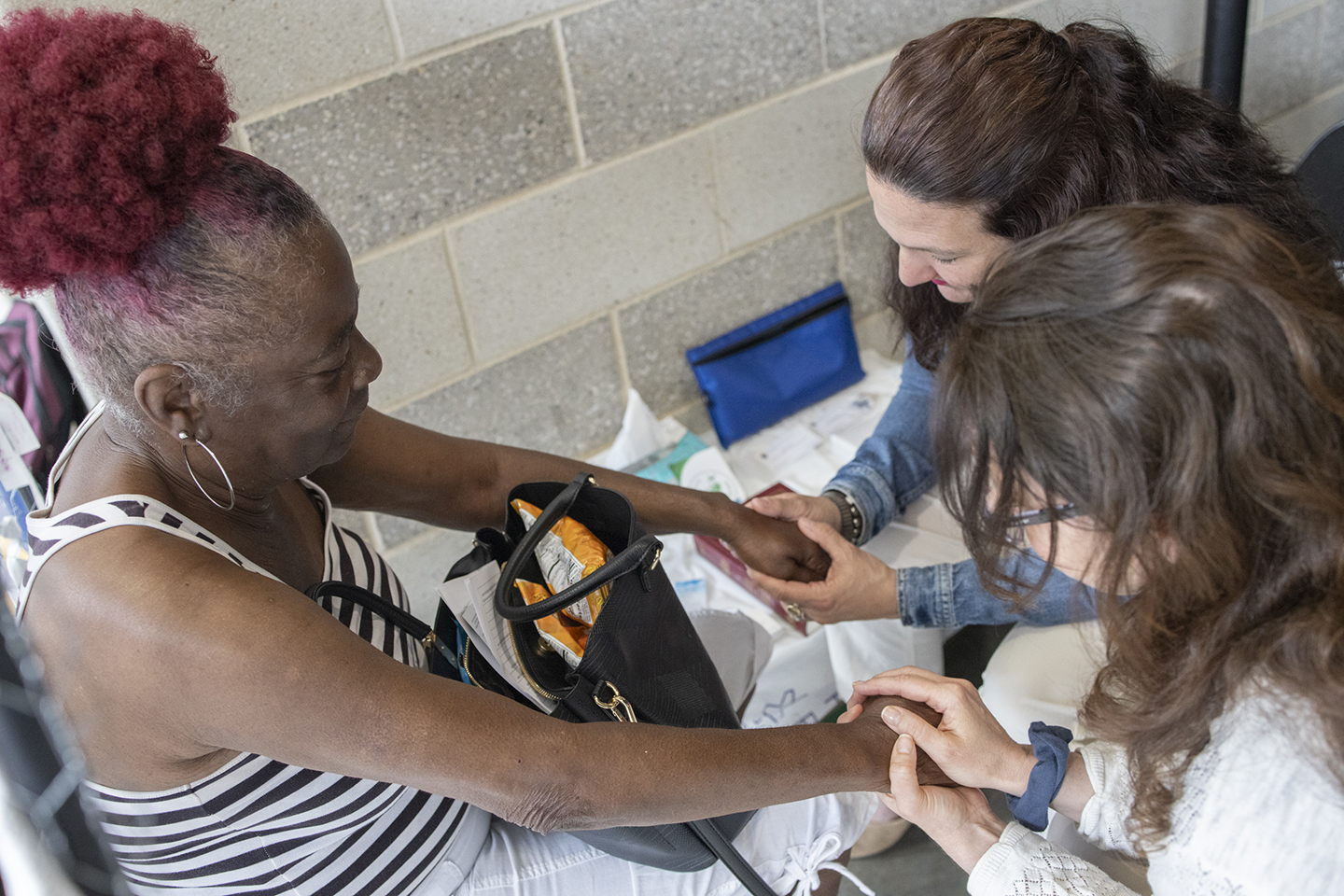Four men answer the call of God to serve as priests
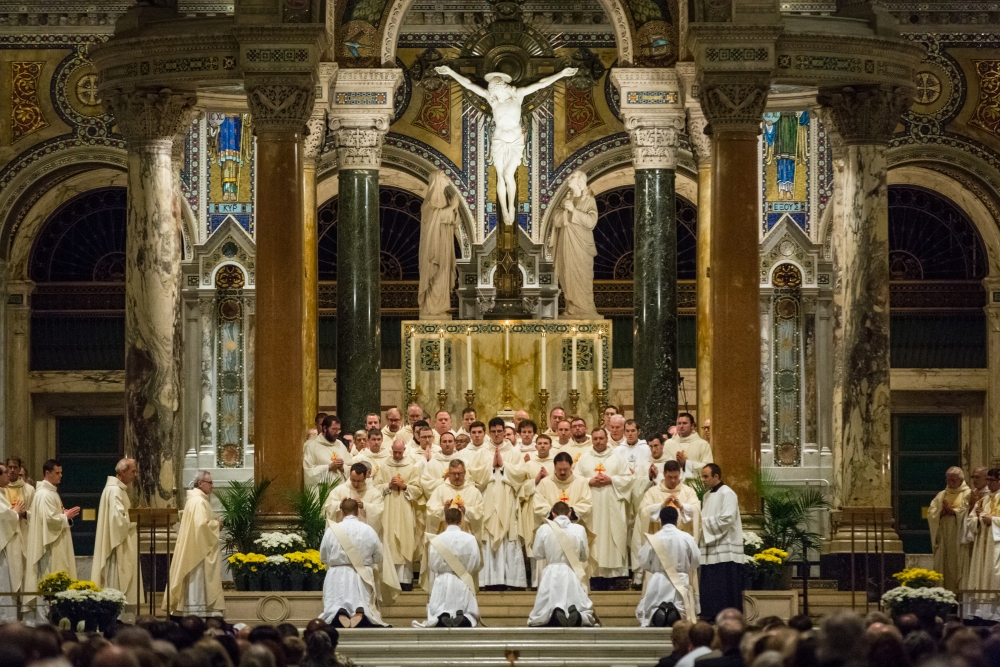
For about 10 minutes in the Rite of Ordination on May 27, the four candidates for the priesthood quite literally laid down their lives for Christ, giving themselves wholly to the holy Catholic and apostolic Church.
Still deacons and within minutes of being ordained priests, Peter Faimega, Michael Lampe, Clark Philipp and John Schneier lay prostrate on the marble floor before the altar at the Cathedral Basilica of St. Louis.
In such moments, face down on the ground, a human being is most vulnerable, neither able to see nor react to trouble from behind. Yet, in the Litany of Supplication, the priestly candidates draw strength and comfort by knowing saints in heaven have their backs.
They can plainly hear the litany as the congregation asks saints to pray for the men so God’s blessings will rain down upon them and their new priestly ministries. Starting with Holy Mary, Mother of God, then with St. Joseph, Sts. Peter and Paul, St. Michael and many more, cantor Scott Kennebeck sang the saints’ names and the congregation responded, “Pray for us.”
The men weren’t down there daydreaming or dosing off either; they were listening intently.
“It’s surreal to hear the names of all the saints, all the amazing giants of the Church,” Father Schneier said. “I’m in awe thinking about them, asking them to help us lying on the floor. That was really, really cool.”
And cold, too, laying prostrate on marble.
“It’s almost jarring,” Schneier said. “You’re sweating and laying on cold marble … but it’s really emblematic of a priest laying down his life. It’s an amazing experience; it makes (ordination) not about me.
“When you are laying in front of altar, you’re very cognizant of everyone who has gone before you, all the martyrs and saints, and also the priests you look up to in the archdiocese.”
After the Litany of Supplication, those now-brother priests followed Archbishop Robert J. Carlson in the laying of hands — a two-minute process in which each knelt before the archbishop for him to confer the power of the Holy Spirit. Then, the priests did likewise to each in a 15-minute procession from the pews to the altar.
The brother priests remained at the altar for the prayer of ordination, the investiture of the new priests’ stoles and chasubles, the anointing of hands and the handing over of the bread and wine to be used in the Holy Eucharist to become the Body and Blood of Jesus Christ, the True Presence.
“When you celebrate Mass, you hold in your hands the Bread of Heaven which is Christ — true food for the life of the world,” Archbishop Carlson said in the homily. “May the Eucharist you celebrate always fill you with wonder and awe, immense gratitude and love as Christ passes through your hands, your voice and your heart.”
Finally, after the bread and wine, Archbishop Carlson gave each new priest the Kiss of Peace, with brother priests doing the same in a 15-minute procession back to their pews.
In a two-hour Mass, the Rite of Ordination took 45 minutes, changing the new priests’ lives forever. After Mass and official pictures, each new priest conferred his very first blessing to Archbishop Carlson, now kneeling before them as they had knelt before him to be ordained.
Here are the stories about how the new priests answered God’s call to the priesthood. …
“I had desired that one day I would serve Him”
 Father Peter Faimega came to St. Louis in 2011 to serve in The Society of Our Mother of Peace, a religious community in High Ridge.
Father Peter Faimega came to St. Louis in 2011 to serve in The Society of Our Mother of Peace, a religious community in High Ridge.
Among the ministries, he did with the community is door-to-door evangelization in north St. Louis.
“I enjoyed doing that so much,” said Father Faimega, who also came to study theology at Kenrick-Glennon seminary.
But at the seminary, surrounded by classmates in formation to be parish priests, he felt called to parish life, celebrating the sacraments — especially Masses and confessions — with a parish family. So, he shifted his focus to ordination for the Archdiocese of St. Louis.
The impetus for that came “so much from my youth,” said Father Faimega, who is the seventh of eight children and has 10 nieces and nephews. He had grown up in a “very good Catholic family” in Nigeria, thanks to Irish missionaries who celebrated Mass in his grandfather’s home. He attended daily Mass at St. Margaret Parish in his home village of Tor Donga in Nigeria, and felt drawn to parish life. Similarly, he had felt “drawn to the faith” as a young boy.
He started to hear the call to the priesthood at about age 12, then began serving Mass a few years later, with inspiration from a parish priest.
“I admired him so much,” he said of the priest, whom he described in an online biography as a ‘”celestial being,’ in charge of the great King in the tabernacle, whom my mom told me died for my sins. I had desired that one day I would serve Him, just as my parish priest did. … His goodness and exemplary life were a source of great encouragement to me in my vocation journey.”
Father Faimega received Catholic grade school and high school education in Katsina-ala, which is about an hour from his village of 5,000. He received a bachelor’s degree from John Paul II Major Seminary in Okpuno, about 220 miles from Katsina-ala.
After a friend introduced him to The Society of Our Mother of Peace, he felt the call to religious life, joined after a retreat and then headed to America. However, he received devastating news before his flight to New York: His dad, Sebastian, had died suddenly, but he was unable to return for the funeral, too far from home and about to leave the country.
“It felt so horrible,” he said. “I miss him so much.”
But Father Faimega persevered after arriving in the U.S. and now, he’s been welcomed into the holy priesthood.
“I’m so so happy,” he said.
“Have you ever thought of being a priest”
 Msgr. David Cox, then the pastor at St. Patrick Parish in Rolla, Mo., was the first priest to pose the priesthood question to Michael Lampe, a student at Missouri University of Science and Technology. He certainly wasn’t the last.
Msgr. David Cox, then the pastor at St. Patrick Parish in Rolla, Mo., was the first priest to pose the priesthood question to Michael Lampe, a student at Missouri University of Science and Technology. He certainly wasn’t the last.
Father Lampe, 33, heard the question time and time again.
“I decided to stop counting after eight different priests asked; that’s not what I wanted to hear,” Father Lampe said, with a laugh. “I didn’t want to be a priest, and I was waiting for God to say, ‘Go ahead, get married and have a family.’ Instead he kept sending priests my way.”
This went on for eight years, from the summer before his junior year at Rolla until he entered Kenrick-Glennon Seminary as a philosophy student in 2011.
“He worked on me little by little,” Father Lampe said. “I was stubborn, but the Lord was very patient and persistent.”
Though Father Lampe entertained thoughts about the priesthood as a young boy, the idea went on the back burner late in his grade school days at Epiphany of Our Lord School. It stayed there through his years as Bishop DuBourg High School and his first two years at Rolla.
But then he had a “reversion” to the Catholic faith of his youth, thanks to his quest to be a nuclear engineer. After his sophomore year, he stayed in Rolla to gain practical experience as a researcher, which was fine during the workday but not so good on nights and weekends. With his friends gone for the summer, he lived alone and filled free time with movies and video games.
“But as soon as the screens go dark, the silence comes back,” he said. “The emptiness was apparent and I did not like it.”
So, one night he prayed for God “to take over because it has to be better than what I had already done with my life,” he said. “He stepped in and a peace came over me, but all of sudden I had all these weird thoughts, ‘Go to Mass. Go to the Newman Center.’ Where is this coming from? But this is what He wants me to do, so I’ll do it.”
Father Lampe became a regular at Mass, and Msgr. Cox noticed his efforts. Father Lampe graduated with a bachelor’s degree in nuclear engineering in 2005, got his masters in 2008, then worked for a few years at a firm near Chicago. Priests kept asking, and he finally answered in the affirmative.
“This is His plan for my salvation and my happiness,” Father Lampe said. “Entering the seminary was the best decision I’ve ever made.”
“Don’t lose the wonder of being in Rome”
 After completing his philosophy degree through Cardinal Glennon College, Father Clark Philipp has experienced the universal Church for the past four years in Rome, including the past three at Pontifical University of Saint Thomas Aquinas, popularly known as the Angelicum. He has lived at Pontifical North American College, a little more than a half-mile from the Vatican.
After completing his philosophy degree through Cardinal Glennon College, Father Clark Philipp has experienced the universal Church for the past four years in Rome, including the past three at Pontifical University of Saint Thomas Aquinas, popularly known as the Angelicum. He has lived at Pontifical North American College, a little more than a half-mile from the Vatican.
He was advised early on: “Don’t lose the wonder of being in Rome,” he said. “Part of the challenge of coming over here is trying to find the balance of learning what we need to learn but taking in the great blessings that we’re offered by the opportunity to come here, spending time with the pope around the city and with the saints.”
The opportunities aren’t solely to benefit the men studying in Rome but “so the people in St. Louis can benefit, too,” said Father Philipp, who discerned a call to the priesthood in parishes after initially contemplating entrance into the Society of Jesus (Jesuit) community.
“I was part way through the application profess (for the Jesuits), but there was a certain aspect that drew me to the seminary,” said Father Philipp, a 2010 graduate of De Smet Jesuit High School. “At the seminary I found peace. I discerned a little more, and God was leading me in that direction.”
In Rome, he studied for a year at the Pontifical Gregorian University, then transferred to the Anglicum.
“I very much love St. Thomas; he has a lot to offer,” said Father Philipp, who discovered St. Thomas through talking with seminarians on high school visits. “When I got to the (Glennon College philosophy) program I just found the clearest explanations came through Aristotle and St. Thomas as well. It was a gradual interest in philosophy and the questions that are important to human life and finding that St. Thomas did a very good job explaining them.”
“Classes (at the Angelicum) have been a great blessing.”
As has been the balance with the wonders of Rome. Father Philipp has made countless pilgrimages to the many basilicas and churches which house the relics of saints. Among them is his namesake, St. Philip Neri. The North American College is about a mile from the Oratory of St. Philip Neri and on Father Philipp’s way to and from school.
“To pray and ask for (the saints’) intersession for my classmates and for myself is pretty cool,” he said.
“All my life, I’ve been preparing for this”
 Father John Schneier sees the hand of God in the entirety of his life, dating to baptism. He cites Father Gary Gebelein, the priest who baptized him, among his influences in answering God’s call to priesthood, along with the late Father Jack Dempsey and many others.
Father John Schneier sees the hand of God in the entirety of his life, dating to baptism. He cites Father Gary Gebelein, the priest who baptized him, among his influences in answering God’s call to priesthood, along with the late Father Jack Dempsey and many others.
“A lot of great priests went through my parish,” said Father Schneier, 24, who hails from St. Ferdinand Parish in Florissant. “They were very influential.”
Mass, specifically the music at Mass, has influenced him, as well. His mom, Patty, who served as a cantor at Sunday Mass, needed an accompanist and looked no further than her 12-year-old son John, who started playing piano at age 4.
Along with priest mentors, liturgical music has played a role in his vocation.
“Every Sunday, I’d be thinking of what songs are we going to be doing,” he said. “At the very least, I had to pay attention to the Mass, so I would know what I had to play.”
Familiarity with the liturgy came in handy after he entered Kenrick-Glennon Seminary.
“I had already learned to think that way,” he said.
Father Schneier played for liturgies at St. Louis University High and also has done so at Kenrick-Glennon Seminary. He graduated from SLUH in 2010 and Cardinal Glennon College in 2013.
Ordination fulfills a lifelong calling.
“The thought of being priest has been around since I was a very little kid,” he said. “It wasn’t at the forefront of my mind all the time, but it was always kind of around. It’s really cool to think that, all my life, I’ve been preparing for this. It’s been building up in my life for the better part of 20 years.
“It’s so remarkable to think that so many things in my life have happened for this. It’s … really, really mind boggling.”
Father Schneier started seriously thinking about the priesthood while at SLUH. He played piano for Masses, led retreats and regularly attended the Steubenville youth conferences in Springfield, Mo. He also attended a family friend’s ordination in North Dakota before his senior year; he was struck by the importance of the priest’s role.
“The priest is called to be an ‘alter Christus,’ or ‘another Christ,’ and bring Christ’s presence to those most in need of Him, especially through the Eucharist and other sacraments,” he said.
RELATED ARTICLE(S):Editorial | Ingredients for a vocation to the priesthood
For about 10 minutes in the Rite of Ordination on May 27, the four candidates for the priesthood quite literally laid down their lives for Christ, giving themselves wholly to … Four men answer the call of God to serve as priests
Subscribe to Read All St. Louis Review Stories
All readers receive 5 stories to read free per month. After that, readers will need to be logged in.
If you are currently receive the St. Louis Review at your home or office, please send your name and address (and subscriber id if you know it) to subscriptions@stlouisreview.com to get your login information.
If you are not currently a subscriber to the St. Louis Review, please contact subscriptions@stlouisreview.com for information on how to subscribe.

